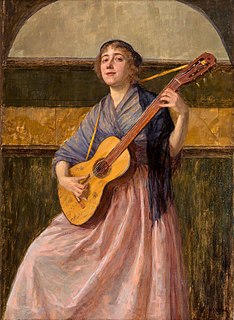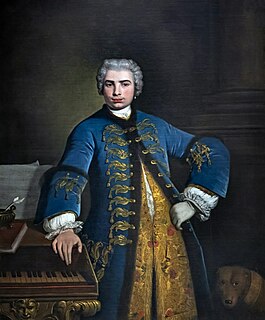
A ballad is a form of verse, often a narrative set to music. Ballads derive from the medieval French chanson balladée or ballade, which were originally "dance songs". Ballads were particularly characteristic of the popular poetry and song of Britain and Ireland from the Late Middle Ages until the 19th century. They were widely used across Europe, and later in Australia, North Africa, North America and South America. Ballads are often 13 lines with an ABABBCBC form, consisting of couplets of rhymed verse, each of 14 syllables. Another common form is ABAB or ABCB repeated, in alternating eight and six syllable lines.
In music, a glissando is a glide from one pitch to another. It is an Italianized musical term derived from the French glisser, "to glide". In some contexts, it is distinguished from the continuous portamento. Some colloquial equivalents are slide, sweep, bend, smear, rip, lip, plop, or falling hail.
Rondo is an instrumental musical form introduced in the Classical period.

Harvard College is the undergraduate college of Harvard University, an Ivy League research university in Cambridge, Massachusetts. Founded in 1636, Harvard College is the original school of Harvard University, the oldest institution of higher learning in the United States and among the most prestigious in the world.
In Western musical theory, a cadence is the end of a phrase in which the melody or harmony creates a sense of resolution. A harmonic cadence is a progression of two or more chords that concludes a phrase, section, or piece of music. A rhythmic cadence is a characteristic rhythmic pattern that indicates the end of a phrase. A cadence is labeled like or less "weak" or "strong" depending on the impression of finality it gives. While cadences are usually classified by specific chord or melodic progressions, the use of such progressions does not necessarily constitute a cadence—there must be a sense of closure, as at the end of a phrase. Harmonic rhythm plays an important part in determining where a cadence occurs.
Empfindsamkeit or Empfindsamer Stil is a style of musical composition and poetry developed in 18th-century Germany, intended to express "true and natural" feelings, and featuring sudden contrasts of mood. It was developed as a contrast to the Baroque Affektenlehre, in which a composition would have the same affect throughout.

Coloratura is an elaborate melody with runs, trills, wide leaps, or similar virtuoso-like material, or a passage of such music. Operatic roles in which such music plays a prominent part, and singers of these roles, are also called coloratura. Its instrumental equivalent is ornamentation.

George Alfred Leon Sarton was a Belgian-born American chemist and historian. He is considered the founder of the discipline of the history of science as an independent field of study. His most influential works were the Introduction to the History of Science, which consists of three volumes and 4,296 pages and the journal Isis. Sarton ultimately aimed to achieve an integrated philosophy of science that provided a connection between the sciences and the humanities, which he referred to as "the new humanism".

The viola organista is a musical instrument designed by Leonardo da Vinci. It uses a friction belt to vibrate individual strings, with the strings selected by pressing keys on a keyboard. Leonardo's design has intrigued instrument makers for more than 400 years, but though similar instruments have been built, no extant instrument constructed directly from Leonardo's incomplete designs is known. Sometimes it is mistakenly referred to as the harpsichord viola, which is a different instrument.

Alison Brown is an American banjo player, guitarist, composer, and producer. She has won and has been nominated for several Grammy awards and is often compared to another banjo prodigy, Béla Fleck, for her unique style of playing. In her music, she blends jazz, bluegrass, rock, blues as well as other styles of music.
In music, fingering, or on stringed instruments sometimes also called stopping, is the choice of which fingers and hand positions to use when playing certain musical instruments. Fingering typically changes throughout a piece; the challenge of choosing good fingering for a piece is to make the hand movements as comfortable as possible without changing hand position too often. A fingering can be the result of the working process of the composer, who puts it into the manuscript, an editor, who adds it into the printed score, or the performer, who puts his or her own fingering in the score or in performance.
Fingering...also stopping...(1) A system of symbols for the fingers of the hand used to associate specific notes with specific fingers....(2)Control of finger movements and position to achieve physiological efficiency, acoustical accuracy [frequency and amplitude] and musical articulation.

A common chord, in the theory of harmony, is a chord that is diatonic to more than one key or, in other words, is common to two keys. A "common chord" may also be defined simply as a triadic chord, as one of the most commonly used chords in a key (I–IV–V–vi–ii), more narrowly as a triad in which the fifth is perfect, in which sense it is alternatively referred to as a "perfect chord" or, more narrowly still, as a major triad only.
Kelefa T. Sanneh is an American journalist and music critic. From 2000 to 2008, he wrote for The New York Times, covering the rock and roll, hip-hop, and pop music scenes. Since 2008 he has been a staff writer for The New Yorker. Sanneh published Major labels: A history of popular music in seven genres in 2021.
Fioritura is the florid embellishment of melodic lines, either notated by a composer or improvised during a performance. It usually involves lengthy, complex embellishments, as opposed to standardized local ornamental figures such as trills, mordents, or appoggiaturas, and its use is documented as early as the thirteenth century. The alternative term coloratura is less accurate. It is closely related to the sixteenth-century practice of diminution or division.

Harvard University is a private Ivy League research university in Cambridge, Massachusetts. Founded in 1636 as Harvard College and named for its first benefactor, the Puritan clergyman John Harvard, it is the oldest institution of higher learning in the United States and among the most prestigious in the world.

Marin Petrov Goleminov was a Bulgarian composer, violinist, conductor and pedagogue.

Villa I Tatti, The Harvard Center for Italian Renaissance Studies is a center for advanced research in the humanities located in Florence, Italy, and belongs to Harvard University. It houses a collection of Italian primitives, and of Chinese and Islamic art, as well as a research library of 140,000 volumes and a collection of 250,000 photographs. It is the site of Italian and English gardens. Villa I Tatti is located on an estate of olive groves, vineyards, and gardens on the border of Florence, Fiesole and Settignano.
Safford Cape was an American conductor, composer and musicologist.
In Greek mythology, Moria was a Naiad nymph dwelling by the river Hermus. She was the sister of Tylus.
A musician named Sant Omer or hailing from the Flemish town of Saint-Omer near of Calais is specified as the composer of a three-voice Sanctus in the early fifteenth century music manuscript, Padua, Biblioteca Universitaria, MS 1475. Fragments of the Sanctus are also found in a manuscript formerly in Budapest, discovered in 1990 but now lost. The style of the piece has been described as "archaic" with modal rhythms resembling those of the Mass of Tournai. It is one of several pieces described as part of the "Stili Vaganti" by Francesco Facchin. Adjacent to the Paduan Sanctus is an Agnus Dei in similar style which may be by the same composer.









